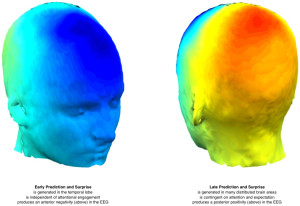Why is a child so much better at catching a moving ball than the most advanced robot? Why do we find unexpected or ambiguous language amusing? How are we so good at attending to the world around us, and yet fall for visual illusions and magic? Latest neuroscience research suggests that this is because the human brain is organised as a pyramid of neural processes that generate successively complex predictions about the future. In recent research from the CBU, led by Srivas Chennu, by measuring the brain’s electrical activity, we show that the information from our senses flowing through this predictive hierarchy is fundamentally altered by what we expect to perceive and what we attend to. Our findings argue that cognition, and ultimately our consciousness, is continually shaped not just by the external world, but also by our internal biases and past experience.
The human brain, it is being increasingly argued in the scientific literature, is best viewed as an advanced prediction machine. By this view, the sophistication with which brains perceive and act upon the world has evolved to minimise the amount of surprise, or unpredictability experienced in a particular situation. Recent advances in neuroscience have generated new theoretical understanding about this intuitive notion, and there is a growing consensus that predictions about the future are realised in the brain by a hierarchy of successively complex neural processes that continually exchange information. Working together, this hierarchy maintains a constantly updated set of beliefs about the causes of events in the external world.
In this work, we lend empirical support to this broad conceptualisation of the brain as a predictive agent, using evidence from cognitive electrophysiology. Drawing upon data from dense arrays of electrodes placed on the scalp (electroencephalography) as well as directly on the cortex (intracranial recordings), we show that some of the most commonly measured patterns of electrical activity generated by the brain can be construed along a hierarchy of predictive processes. By reconstructing the sources of these electrical impulses, we show that this hierarchy is implemented primarily in temporal and frontal regions of the brain. Importantly, we show that if the brain is indeed a hierarchical prediction engine, we can test this by examining how it learns from its mistakes, or prediction errors.
Our findings suggest that information flow along this predictive hierarchy is crucially modulated by the engagement of attention, and is finely tuned by our prior expectations, or predictions, about future events. Successively complex neural processes are involved in predicting the future, and thereby try to explain away expected prediction errors generated at lower levels. Only information about failures in prediction flows up the hierarchy, and results in the revision of expectations about the future. Ultimately, this research offers a broad, elegant, and neuroscientifically grounded explanation of how brain deals with an ever-changing external world. It reasserts that cognition, and ultimately our consciousness is fundamentally shaped not just what is out there, but also by our biases and expectations, which themselves are governed by our past experiences.
S. Chennu, V. Noreika, D. Gueorguiev, A. Blenkmann, S. Kochen, A. Ibáñez, A. M. Owen, and T. A. Bekinschtein. Expectation and attention in hierarchical auditory prediction. The Journal of Neuroscience, 33(27):11194–11205, 2013.

 MRC Cognition and Brain Sciences Unit
MRC Cognition and Brain Sciences Unit



